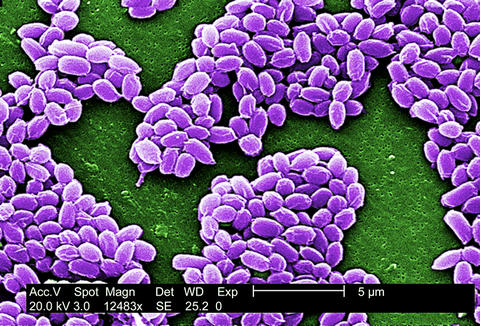
This scanning electron micrograph shows spores from the anthrax vaccine strain of Bacillus anthracis. These spores can live for many years, enabling the bacteria to survive in a dormant state. The spores range in size from 0.5 to 2 micrometers (millionth of a meter).
It may not be as catchy a combination as "Miss Scarlet in the parlor with a revolver," but "polyester-rayon wipes in the field followed by saline-surfactant extraction and vortexing" is the most efficient solution to an important biological game of "Clue" deduced by researchers at the National Institute of Standards and Technology (NIST). As reported in a recent paper, the NIST team studied different methods for collecting, extracting and quantifying microbial spores from indoor surfaces to estimate parameters that should be considered in the development of a standard biological sampling protocol. A precise and reliable recovery system is critical to evaluating the success of cleanup efforts following an accidental biohazard contamination or bioterrorist attack (such as the Bacillus anthracis spore-laden letters sent to Congress and elsewhere in 2001).
Technique matters. The NIST team found that the optimal method in their experiments was about 10 times more effective at recovering spores than the worst method, and that recovery dramatically improved by simply adding a surfactant to the extraction solution.
"A comprehensive look at the impact of protocol variables affecting the performance of spore recovery—especially when dealing with serious threats such as anthrax—is an important national homeland security priority," says lead researcher Sandra Da Silva. "In this study, we used Bacillus anthracis (Sterne), a vaccine strain, as a surrogate for Bacillus anthracis (Ames), the causative agent of the anthrax disease, in order to learn how to improve the low efficiency of current protocols."
Possible explanations for the poor results, Da Silva says, include using wipes made from materials that do not attract bacteria well or won't let go of collected bacteria, extraction liquids that fail to completely loosen spores from the wipes and get them into solution, or inadequate dissociation methods that leave spores clinging to the walls of the recovery container. To determine how to avoid these obstacles and maximize the quantity and quality of the spores recovered, the NIST researchers studied different combinations of the three experimental factors: the type of wipe material (polyester, cotton or polyester-rayon), the type of extraction solution (deionized water; deionized water with Tween 80 surfactant; phosphate-buffered solution (PBS) or PBS with Tween 80) and the method used to agitate the solution to loosen the spores from the wipe after collection.
Polyester-rayon proved to be the most efficient material for the spore collection wipes, a result that the researchers suspect is due to the chemistry and structure of the fibers. Extraction solutions with a surfactant worked better at removing spores from the wipes and getting them into solution. This, the researchers believe, is because the detergent-like character of the surfactant loosens the bond between the spores and the wipe surface similar to the way soap loosens dirt from skin. The surfactant also coated the sides of the recovery container, helping keep the spores from sticking there. Finally, the researchers observed that vortexing (mixing by rapid spinning) physically removed more spores than sonication (sound waves applying force).
Of the three protocol variables studied, the most critical to a successful recovery of B. anthracis (Sterne) spores is the type of extraction solution used, Da Silva says.
The findings from this study are being used to develop an ASTM protocol for bacterial surface sampling. Additionally, the team is conducting a similar study with microbes that are more sensitive to environmental conditions, including Gram-positive (Bacillus cereus) and Gram-negative (Escherichia coli and Burkholderia thailandensis) bacteria.
S.M. Da Silva, J.J. Filliben and J.B. Morrow. Parameters affecting spore recovery from wipes used in biological surface sampling. Applied and Environmental Microbiology, Vol. 77, No. 7, pages 2374-2380, April 2011.

